by Jenny Rose | Feb 1, 2018 | Connection & Community, Emotional Intelligence
Today is laundry day, and I’m sitting in the laundromat writing this week’s post.
I’ve always liked doing laundry. Turning a bundle of dirty clothes, sheets and towels into neat, fresh-smelling folded piles gives me a warm feeling of satisfaction and accomplishment.
At present, we don’t have a usable washer at home, so part of our routine is to hit the laundromat every couple of weeks. We know it’s time when my partner runs out of socks and I run out of underwear. At that point we collect dish and bath towels, sheets and clothing, and our stash of quarters and head into town.
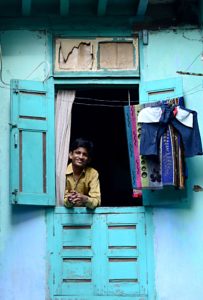
Photo by Pop & Zebra on Unsplash
Sitting here, I watch a man open the mouth of a bulging cloth laundry bag and empty it into the machine. I see scrunched up socks, some more hole than sock; inside-out pant legs, whites, colors, sleeves and bandanas all tangled and mixed up together. He feeds in quarters, adds soap and sets the temperature to hot before heading back out, either to sit in his truck in the parking lot or otherwise kill time until the load is done.
I get a lot of pleasure out of the laundromat. Watching people deal with their laundry is every bit as entertaining as looking at someone’s bookshelves. Dirty laundry is a great social leveler. We all have it, and if we don’t deal with ours directly, someone else does. Our dirty laundry records the story of our lives. Our scent is imprinted on it. The presence of our pets decorates it. It remembers the day we spilled our coffee in the car, the morning the hot grease spattered and the nosebleed we had in bed. It gives away our cigarette habit and the acrid, sweaty smell of our secret copious alcohol consumption.
Two middle-aged women come in with stuffed pillowcases, a couple of plastic laundry baskets, a heavy green garbage bag and a couple of drawstring laundry bags, and commandeer a whole row of machines. They work well together, efficient and brisk. Obviously, they’ve done this before. They sort lights from darks, taking care to untangle and unscrunch as they load the machines. They check pockets. One of them goes from machine to machine with soap and the other with quarters. They choose hot water for the whites and warm for the colors. I wonder if they are friends, family members or from an organization like a shelter or a boarding house. Perhaps they’re church ladies dealing with donated clothes for charity. The washing machines take 39 minutes, and then the women load up a bank of dryers. As the dryers finish, they work together to fold bedding, mate socks, and put shirts on hangers. I see no children’s clothing, only adult size. One of them says to the other they’ve spent over a hundred dollars, and I wonder how often they do this. It takes them three trips to load up a battered van with all the clean clothes, and off they go.
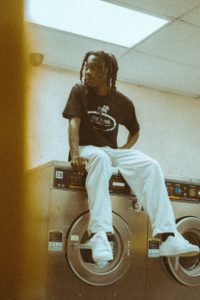
Photo by frank cordoba on Unsplash
Dirty laundry is a cultural artifact. Back in rural Colorado, Wranglers, snap button shirts and lots of bicycling, hiking and yoga gear slosh in the machines. Here in central rural Maine everyone wears Carhartts, long underwear and thick socks. This is a blue collar community, where farmers, heavy equipment operators, sawyers and mill workers wear the same lined heavy canvas and flannel working clothes all winter.
A worn-out looking young women with a little girl comes in. Mom loads up the washer while the little girl helps by handing her things. I see no men’s clothes in this load. They sit down at a round table, the little girl with a grubby board book she found in a basket of children’s toys in the waiting area. Mom, after checking her cell phone briefly, sits idly, now and then glancing at a TV screen on the wall where a movie I’ve never seen is playing with the sound muted.
When I came to Maine, my partner had a routine. Everything went in the same machine. Socks were permanently turned inside out, because he can’t tolerate the feel of the seams against his toes. It all got OxiClean, soap and hot water. He likes things machine dried so they’re soft.
I quailed. Half of my clothes were cold water wash. I always separated colors. I much preferred to line dry.
Negotiating The Right Way To Do Laundry is one of the many hidden landmines in every living-together relationship that no one ever talks about.
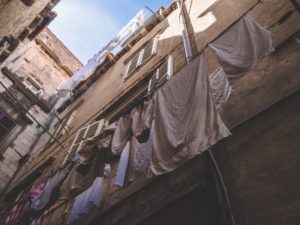
Photo by Jonas Tebbe on Unsplash
Being old and wise about choosing our battles, we adjusted to one another. I stopped trying to turn his socks right-side-out. I learned to keep my cold water wash separate. I decided life was possible if I didn’t separate whites from colors and he decided clothes were still wearable if washed in warm water instead of hot. I line dry my things and machine dry his. I don’t waste time folding his clothes, because he prefers to keep them stacked neatly in a laundry basket that lives on the floor next to his side of the bed. I fold and roll my clothes, just as I always have, for my sock drawer, my underwear drawer, my tee shirt drawer and the closet shelf where my jeans live. We happily share the expense and the work.
A woman my age with a thick Maine accent and hair an improbable rich brown with no grey comes in with a load. She’s very short, and can’t reach the top of the big commercial washer to put in detergent. She goes to the counter and gets a step stool from the attendant. Her load is comparatively small and consists of a couple of violently flowered towels, jeans, shirts, socks and underwear, all looking as though they belong to her.
I love to sit and watch the contents of the washer go around through the porthole window. The gush of water, the frothy bubbles of soap and the rotating clothes give me a feeling of all’s-right-with-the-world comfort. In a crazy world, stained by so much hate, bloodshed and tragedy, here’s something within my power. I can do the laundry.
Watching the clothes whirl is like watching the inside of my head. Amongst a jumble of ideas, thoughts, feelings and memories, bits and pieces show themselves or claim my attention for seconds or minutes or hours or days, only to disappear as other colors and patterns come to the forefront of my mind. Now I catch a glimpse of my favorite pair of underwear, purple with turquoise spots. That’s like the brilliant scene, passionate and gripping, I want to write today as I work on my second book. Then a heavy brown sock shows itself, one of the pair I wore on the day I did Tai Chi in the church basement, sock-footed on the cold floor, reminding me that after this I’ll swim, and tomorrow is another Tai Chi day. White socks tumble by too quickly to tell if they’re mine (right-side-out) or my partner’s (inside-out). We need to run to the store. My partner did this chore last time. It’s my turn, but I don’t want to do it today. Tomorrow after Tai Chi? What’s on the grocery list? The sleeve of a plaid flannel shirt plasters itself momentarily against the window and is pushed away by the leg of a pair of heavy canvas Carhartts. Why are men’s Carhartt canvas pants size 32 x 30 a perfect fit, but the same size in denim is too big? The red cloth napkins we’ve been using flutter past.
The expression ‘airing your dirty laundry’ makes me smile. Oh, the shame of admitting feelings, anxieties, mistakes and less-than-perfection! Those unsightly yellow sweat stains under the arms of our shirts must be hidden from the eyes of the world at all costs, along with our humble granny panties, our favorite tattered and torn ancient tee shirt and the old towel the cat lies on. Whatever happens, we mustn’t confess the tangled smelly jumble we occasionally make out of our lives, or uncover our wounds and scars. We must never reveal neglected, malodorous piles of stained laundry in which our hope, innocence or self-esteem are buried.
Some people think admitting to dirty laundry is simply not nice. It lacks class. It’s impolite, and breaks the code of maintaining appearances at all costs. The Emperor is certainly wearing clothes, and they’re never dirty.
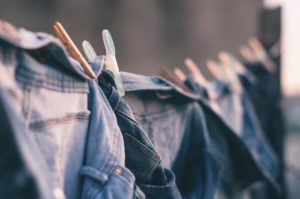
Photo by Bruno Nascimento on Unsplash
I challenge that. Cleansing is a sacred act of courage and wisdom. If we can’t clean out our infected wounds and cleanse our spirits, our homes and yes, our laundry, our lives won’t work well. Beating, shaking, washing and airing our laundry in the sun and fresh air is an act of healing and renewal. Allowing the world to see our dirty laundry is the beginning of cleansing and repairing, the beginning of uncreasing, unscrunching and untangling the things that disempower us. Doing laundry is a spiritual practice, a reminder that we are just like everyone else, an offering to others of our authenticity and humanity.
All content on this site ©2018
Jennifer Rose
except where otherwise noted
by Jenny Rose | Jul 27, 2017 | Connection & Community, Emotional Intelligence, Holistic Management
My partner and I have hired a permaculture group called the Resilience Hub out of Portland, Maine, to collaborate with us in the development of a 30-year plan for our 26 acres.
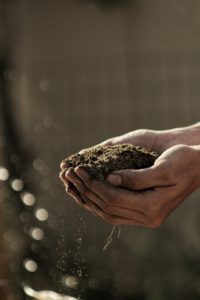
Photo by Gabriel Jimenez on Unsplash
Permaculture, for those of you who didn’t follow the above link, is “the development of agricultural ecosystems intended to be sustainable and self-sufficient.” In other words, it’s a holistic management plan that includes plants, animals (insects, birds and reptiles), people, water and land. The land we live on consists of wetland, a river, a pond, a year-round daylight spring, streams, fields and woodland.
That’s what we tell people, anyway. I’m beginning to understand what permaculture really means to me, though, is a commitment to love.
I’m interested to discover I’ve achieved the ripe old age of 53 and discarded nearly my entire definition of love after two marriages, two long-term non-marriage relationships and raising two children. At this point I know a lot more about what love isn’t than what it is.
Here’s my current working definition: A relationship revolving around what we want others to be is not love. A relationship revolving around the question “Who are you?” is love. Notice sex is not part of the definition. I’m talking about love in the wide sense here, the act of loving another human being, independent of legal or blood ties. For me, this is also the root of self-love. Do we endlessly tell ourselves what we should, must, and have a responsibility to be, or do we allow ourselves to discover who we in fact are?
Creating a permaculture plan for this piece of land is a deliberate and intentional journey into what the land and the life it sustains is, as well as what we are as individuals and as partners. From our most private thoughts and beliefs to the boundary of the 26 acres we live on, we become note takers and observers. We practice surrender and acceptance. We listen and watch with curiosity and attention. We are present every day with ourselves, one another, and the land. We don’t think about imposing our will. We think about collaboration and cooperation, weaknesses and strengths, effectiveness and healing.
The consent to see and be seen is a profound and intimate expression of love rippling from the inside outward. We are not intruders here. We inhabit this land and want to protect and preserve it. The porcupine living in the barn cellar, the owls down by the river, the phoebes nesting in the barn, the passing bear who wiped out our suet feeder, are not intruders, either. The poison ivy, stinging nettle, ticks and mosquitos live here. The snapping turtles in the river and the leeches in the pond call this place home, just as we do. Permaculture is a peace treaty, the practice of appreciation for the variety and complexity of life around us, and the humility to admit much of its elegant mystery is beyond our knowledge or understanding.
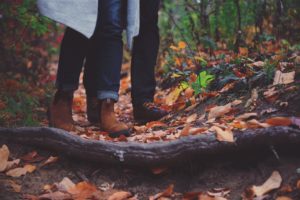
Photo by Takahiro Sakamoto on Unsplash
As I walk these acres, alone, with my partner or in a group with the Resilience Hub, I’m learning the land as I would learn a beloved’s body. I’m noticing the animal trails wandering from field to forest to river, lines and wrinkles of use tracing their way along the land’s contours and folds, suggesting where we, too, might make a path, a place to pause, a spiritual resting place.
I map old stone walls like the delicate sculpture of a spine, huge mossy boulders and landmark trees, learning the texture and landscape of this place. I wander in the thin-skinned places where old bones of ancient glacial esker are revealed. I think about bird nesting boxes, bee and pollinator boxes and honeybee hives.
Over the years, my partner has discovered all the delicate veins of water, daylight and underground, seasonal and year round, the lifeblood of the land. Thick forest hides damp, humid hollows and shallow bowls where mosquitoes fill the leaf-dappled air and the turkey and grouse hide. The grassy hair on the open slopes and fields is twined, in this season, with black-eyed Susan, purple vetch, queen Anne’s lace, wild pinks, blooming milkweed, and red clover.
The land shows us where wildflowers thrive, and which type decorate which season. It demonstrates where water runs, so we know exactly where to position a well. The trees inform us of water availability, drought, crowding, disease and age. The raptors flying over us, hunting, help us know where raptor roosts would be welcome in order to protect the woody agriculture we think of introducing against rodent damage.
As we wander this terrain, we look for nothing and try to see everything. This is how the sun falls during each month of the year. This is where the field floods when the river ice dams thaw in the spring. This is where the doe that was hit on the road lay down and died. This is the special spot where I come, early in the morning, to sit by the river and be alive. This is where the wind strokes the exposed slope, and this is where the trees shelter a small clearing that catches the sun. This is the place where a bittern pounced like a cat on some small rodent by the pond one morning. Here the snow drifts, and here it lies late in the season as the bluets bloom in the boggy field. Here was the old fox den.
Trees topple, decay into humus where fungus thrives and new trees reach for the sun. The land stretches, sheds, sloughs away and reconfigures. Species populations rise and fall. We aspire to that resilience and sustainability. We aspire to the harmony and complexity innate in the landscape around us. We don’t want more than we need to eat, to live, to love. We don’t want to be well-groomed, civilized, obedient and sterilized. We want to root the rest of our lives in the color and scent and texture of the primordial wisdom of life and death as naturally and unapologetically as the raven, the fern or the tree.
Who am I? Who is my partner? What is this land? I believe these are questions that open the way to true love; to sustainability; to reciprocity, respect and surrender. As long as we ask and cherish these questions and receive and cherish the answers, hour by hour, day by day, season by season, cycle by cycle, love endures.
All content on this site ©2017
Jennifer Rose
except where otherwise noted
by Jenny Rose | Jul 20, 2017 | A Flourishing Woman, Body
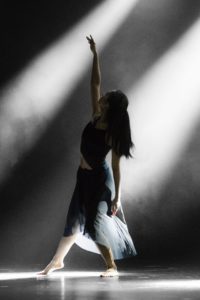
Photo by Leon Liu on Unsplash
Last night we danced. I’m patiently and persistently attempting to root a dance group into this community. It’s taking time, but I hope in the end to have a healthy core of four or five women with whom to share this sacred practice.
As I danced, I remembered an old friend with whom I danced in Colorado. She used to often say, at the end, as we sat in a circle holding hands, “It’s so good to be in the body.”
Not in the head, where family and other relationships, financial and political complexities, expectations, rules, to-do lists and all our internal voices reside, but in the body, right now.
Our bodies contain a childlike innocence and a wisdom beyond words. They communicate to us the truth about how things are with us via feeling and sensation. Patiently, they carry us through our lives, our most loyal and faithful companions. Persistently, we neglect, abandon and abuse them.
Somewhere along the way, we’ve learned to reject, be ashamed of and hate our physical being and experience. Now we’re to the point where bodily functions tied to being biologically female are a matter of political incorrectness and a hate crime. Social pressure is increasing to eradicate the very words that define female physical experience.
But dance is for everybody in every body, and the spiritual practice of dance has taught me to honor, protect and care for my physical self in new ways. There are no labels in dance, no gaslighting, no power-over that seeks to diminish or limit my physical history or expression. Dance is wordless, so there are no language police. Dance is the freedom to belch, to fart, to wiggle, to jiggle, to giggle, to cry, to shout, to play and to sweat.
Allowing my body to be and joyfully inhabiting it has been a powerful act of self-love. It means allowing my hair to grow as it will, where it will, in the color it is. It means moving with dignity and pride. It means gratitude, for my life is a journey mapped onto my flesh. Every mole, freckle, stretch mark, scar, lump, bump, line, wrinkle and vein holds part of my story, and I honor story.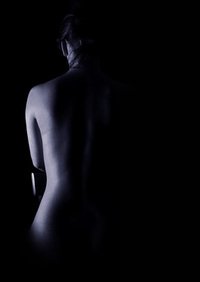
Being in my body is a powerful act of surrender, not to what the culture says I must be or not be, not to what I think I should embody or not embody, but to what I am. Simply that. The unique, miraculous complex system of genetic material, living tissue, viruses, bacteria and chemical processes that I am.
Allowing my body to be is a peace treaty. My body is not for the pleasure or evaluation of others. It’s not for sale. My body and I owe nothing to anyone, not explanation, apology, conformity, obedience and especially not shame. I refuse to go to war over gender, sexuality or political correctness ideology. I decline to support or participate in self-hatred or hatred of other bodies. The power of my body transcends the judgements, criticisms and opinions of others.
The deepest language I know is of the body. Words are inadequate to my passion, to my love, to my creativity. Spoken and written language fails to convey the richness of my body’s capabilities.
The tick crawling high on the nape of my neck along my hairline, the feel of its tiny claws stirring each hair as it seeks a good place to fasten on, gives me a physical experience so vivid and visceral it cannot possibly be conveyed in words. My skin shrinks, telling me what the sensation is before I examine the cause with my eyes. Undisturbed hair around its path rises, quite automatically, in response to the small but ominous trespass. It feels solid and smooth as an apple-seed between my thumb and finger as I pinch it off. It hurries up and down a bookmark, chestnut colored, as I transport it down the stairs, almost as though it knows it’s been seen, recognized and a death sentence passed.
We come out of our favorite restaurant after a meal on a hot, humid day and find a snake clothed in brown and green, voluptuously twined around our right front tire. My partner stoops and grasps it and it curls and writhes as it dangles from his hand, twisting between the newly-laid black tar and the heavy sky, glaring with sun, humid as a steam bath. My partner takes it into a nearby field and as he comes back he holds out his hand with a rueful expression, showing me beads of bright red blood, dazzling as rubies, on his finger, and two parallel shallow cuts that sting, he says, like paper cuts.

Photo by Leon Liu on Unsplash
Last night I danced with the tick, the snake, the rasp on my knee from falling on the front cement steps, their uneveness hidden by the encroaching hostas, blooming now on thick, fleshy stems, their lavender flowers plundered all day by bumblebees.
I danced with the rattling air conditioner lodged into a window of the recreation center activity room. As usual, we traded the rise in heat and humidity in the room with the lower and quieter fan setting.
I danced with a dead fly on the wood floor, trying to avoid stepping on it with my bare foot. I danced with a living large black ant, bewildered, crawling across what must have seemed like acres of flat, featureless terrain, also not wishing to step on it, but too involved in the flow of the music to stop and take it outside.
I danced with my breasts and belly and thighs, with my feet and elbows and wild hair. I danced with trickles of sweat and a wet upper lip. I danced with my tattoo and swaying earrings and sliding silver bangles. I let myself go. I let myself be. I let myself sink into my body as though sinking into a lover’s arms, for I am my body’s lover, and it is mine.
I danced, and remembered again how good it is to be in the body.

Photo by David Hofmann on Unsplash
All content on this site ©2017
Jennifer Rose
except where otherwise noted
by Jenny Rose | Apr 20, 2017 | Power
I came across a prayer to Baba Yaga recently. I’ve spent a lot of time with Baba Yaga, who is a supernatural female figure out of Slavic European folklore. I’ve told stories about her for years, and she’s an important character in my book. She’s a powerful life-death-life-death figure and has many names, among them Storm Raiser, Primal Mother, Lady of Beasts and Mother of Witches. In spite of our long acquaintance, I’ve only lately begun to love her.
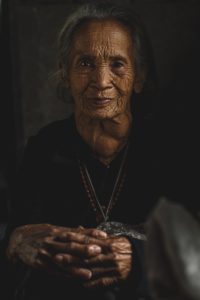
Photo by ivan Torres on Unsplash
Sometimes I think the most important thing to understand about life is power. It structures every single relationship, most of all our relationships with ourselves. Power creates wars, cults, murderers, abusers, tyrants, rebels and perhaps angels.
I believe we have a great longing for our individual mislaid power, such a longing that we’ve lost track of what it is or how to recognize it in our hunger and desperation. I don’t know how else to explain our mindless obedience to the media, to our culture, to our religions, to the almighty “they” who instruct us how to live, how to eat, what to believe, how to look, how to buy and how to be.
At this time in my life, and at this time in my country’s history, I cling to Baba Yaga, because she represents sanity in a world becoming more insane by the day. The prayer reminds me of what true female power is — and is not.
True female power wastes no time on despots and bullies who conceal their fear and impotence behind dishonesty and the willingness to use force. It’s not her business to prop them up. They have nothing she needs and they’re not worth her attention, for they shall not endure.
True female power is real. It’s authentic. It’s not bound by chains of political correctness, manners, fear or ideology. A woman in her authentic power is, according to need and whim, a child, a wild woman, a bitch, a seductive temptress, a crone, and a creature of magic. Obedience and compliance are not in her nature.
True female power seeks the hidden thing, within and without. She pares away layers, stories, masks, facades, dreams, visions, expectations, and shoulds. She’s a persistent poker, prier and meddlesome busybody in holey tennis shoes. She opens drawers, boxes and jars, looks behind forbidden doors and never stops asking questions. She refuses to shut up, close her eyes or pretend, and views everything by the stark light of a fiery skull without flinching. She doesn’t need anyone to agree with her, and she doesn’t need everyone to agree with her. She doesn’t argue with what is. The truth cannot escape her.
True female power doesn’t prostitute for love and validation. Baba Yaga eats sulfur to make her farts more momentous and fertilizes her body hair to make it grow more abundant. She’s hairy legs and iron-tipped fingers and teeth sharpened on bones. She takes a lover when she feels like it, but she kicks him out of her bed before dawn and doesn’t offer breakfast. Her body is not for sale, her hair is the color it wants to be, and she has no use for a painted mask over her face.
True female power is a teacher of magic. She teaches the sorting of one thing from another, cleansing, lighting a fire, the alchemy of cooking. She’s the power of the cauldron, the cup, the womb and the growing seed. She’s the wisdom of bone and blood, seed and water, life and death. A woman in her authentic female power learns to feed and nurture the magic of her intuition and creativity. She knows they are the most priceless jewels she will ever have.
True female power feels huge, deep feelings of rage, grief, joy and lust. When fear accosts a woman in her power, she spits in its eye and knocks it down on her way forward. An authentically powerful woman knows how to cause earthquakes with her dance, bring rain with her tears, melt rocks with her passion and sow stars with her joy. She allows no one to make her small.
True female power expresses all her fine feelings. She shrieks, curses, cackles, stomps, grumps, slams and mutters. She will not be silent. She stays up all night drumming and dancing if the mood takes her, and sleeps all day when she wants. She collects secrets, stories, marbles and insults with equal enjoyment. In fact, she says and does exactly what she wants to do and say.
(Yes, I said marbles.)
True female power is ancient and enduring. It’s coarse silver hair, aching bones, pearly stretch marks, lumpy thighs, scars and wrinkles and cracks and crevices. A woman in her power bleeds, first red and then the invisible silver blood of wisdom that arrives when the children of her body have become ghosts living only in her memory. A woman in her full authentic power smiles kindly on the young and beautiful, because they are not yet capable of her wisdom.
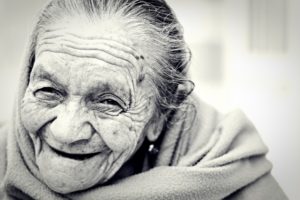
Photo by Cristian Newman on Unsplash
True female power knows how to live through the night alone, how to wander in the desert, how to go underground and live in a cave among the roots of life when necessary. She survives the conflagration, the invasion, the prison sentence, the betrayal, the loss, the beating, the chaos, the flood. A woman in her authentic power is rooted in the stars, in the trees, in the mountains, in the sea and in the earth. She welcomes cycles and seasons. Change is her strength. She knows how to bide her time and let die what must, because she knows her power will endure in women who come after her.
A woman in her power is not confused. She knows there’s no authentic power in money or position, youth or beauty or hairless legs. She knows her wellspring of power is internal and if she can’t find it, no one will. True feminine power defines her own success, her own goals, her own agenda, her own spiritual practice, her own beauty and her own rules.
Baba Yaga’s specialty is too-good maidens of all ages. That’s how I met her. When the Baba is finished with such a maiden, she’s either saltier and wiser or dead. Baba Yaga eats the dead ones with vinegar to cut the sweetness.
It’s a good time for prayers. Perhaps it’s always a good time for prayers. Here’s mine:
Baba Yaga, Grandmother, we offer you our sweat, tears, blood, milk and urine. Initiate us into life and death with our own blood and bone. Lead us back into love for ourselves, our bodies and our earth. Help us, your daughters, find our authentic feminine power again.
All content on this site ©2017
Jennifer Rose
except where otherwise noted











